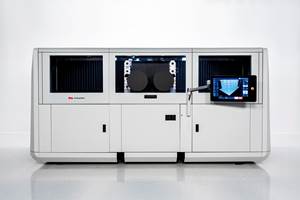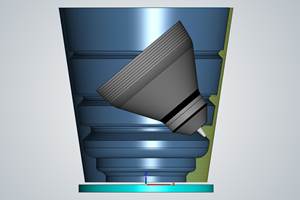Materials Are the Most Important Component in AM
You will see a lot of additive machines at IMTS. Success with those machines is determined by an underappreciated ingredient. Read our collection of recently published articles focused on materials.
Share
Read Next
When people consider the advance of additive manufacturing (AM), they tend to think of the machines. The processes for additively building industrial parts are still advancing, new processes are still coming, and the machines that apply these processes continue to evolve in terms of capability, capacity, efficiency and features. Additive machines continue to captivate. 3D printers are—forgive me—really cool.
But here is the thing: The machine itself is not the end user’s experience of AM. The end user is the one who receives the part, and this person likely will not see the machine on which it was made. She might not even know it was made additively. But that user will experience the material. For as the long as the part is in use, for as long as it functions whether well or poorly, the user will live with the material choice that was made for that part.
Materials are thus the most important component of additive manufacturing.
Challenge me on that statement if you wish. Surely the additive machines must be the most important component of AM? My response: The machines deliver value only by applying a material. The machines’ ability to solve problems is entirely defined by the range of materials available for them to apply.
And in the particular case of metal additive, materials also represent perhaps the greatest area of opportunity. Additive processes make it possible to achieve alloys and other metallics that can’t be realized any other way. The most recent Rapid + TCT show, for example, saw not only new metal matrix composites achievable only by AM, but also the introduction by metal supplier Arconic of multiple new aluminum alloys, including one that achieves greater strength at high temperatures compared to conventional alloys by leveraging the rapid solidification rate of powder-bed AM. In other words, the design freedom of AM encompasses not only geometric freedom, but the freedom to realize new metal properties.
Recognizing all this, we have made a very deliberate choice in recent weeks, at this moment in the year. We are fast approaching the International Manufacturing Technology Show (IMTS), which has become a leading event for additive manufacturing technology. IMTS will offer attendees the chance to see many additive machines, including some being launched at the event. See our collection of previews of what will be seen at the show. And to support and complement this experience, we chose to pursue articles on materials, so we could publish an issue of the magazine on this theme. The materials are the enablers to all the additive machines you will see at IMTS.
The theme is big. In covering materials, there is much to say. Articles we’ve recently posted explore topics including:
- Polymer development for AM
- Metal powder evaluation on a system that can also inspect the build
- AM for high-performance ceramics
- The arrival of special metals available solely because of additive
- Resilient soft materials allowing machines to mimic muscles and skin
- A material for NASA withstanding temperature extremes, chemicals and electrical charges
We are on the cusp of a materials moment in additive manufacturing. That prediction follows inevitably from the role that AM technology is now finding, the role that will be seen at IMTS. Those machines are now being applied to production. They are becoming more capable for production. So, as the very next step, the users of those machines will look to materials. They will turn to materials engineers to give them exactly the material properties required to meet the needs of those users of the parts produced through AM.
Related Content
3 Points About 3D Printing Large Parts We Can Learn From the Lunar Habitat (Video)
Ingersoll Machine Tools describes the capabilities and promise of large-scale additive manufacturing as seen in the 3D printed sections of the Rosenberg Space Habitat.
Read MoreAM Workshops: The 3D Printing Conferences at NPE and IMTS 2024
We are presenting half-day conferences on additive manufacturing at both of the two largest manufacturing events in North America this year. Join us!
Read MoreDesktop Metal’s P-50 Metal 3D Printer for Mass Production
IMTS 2022: The company says the printer’s bidirectional, area-wide printing enables production quantities of up to millions of parts per year at costs competitive with conventional mass production techniques.
Read MoreHyperMill CAM Software for Hybrid Manufacturing
IMTS 2022: The hyperMill CAM software features an additive manufacturing capability option, which is said to provide efficient hybrid processing with simultaneous additive and subtractive processing on one machine.
Read MoreRead Next
4 Ways the Education and Training Challenge Is Different for Additive Manufacturing
The advance of additive manufacturing means we need more professionals educated in AM technology.
Read MoreAt General Atomics, Do Unmanned Aerial Systems Reveal the Future of Aircraft Manufacturing?
The maker of the Predator and SkyGuardian remote aircraft can implement additive manufacturing more rapidly and widely than the makers of other types of planes. The role of 3D printing in current and future UAS components hints at how far AM can go to save cost and time in aircraft production and design.
Read More3D Printing Brings Sustainability, Accessibility to Glass Manufacturing
Australian startup Maple Glass Printing has developed a process for extruding glass into artwork, lab implements and architectural elements. Along the way, the company has also found more efficient ways of recycling this material.
Read More


















